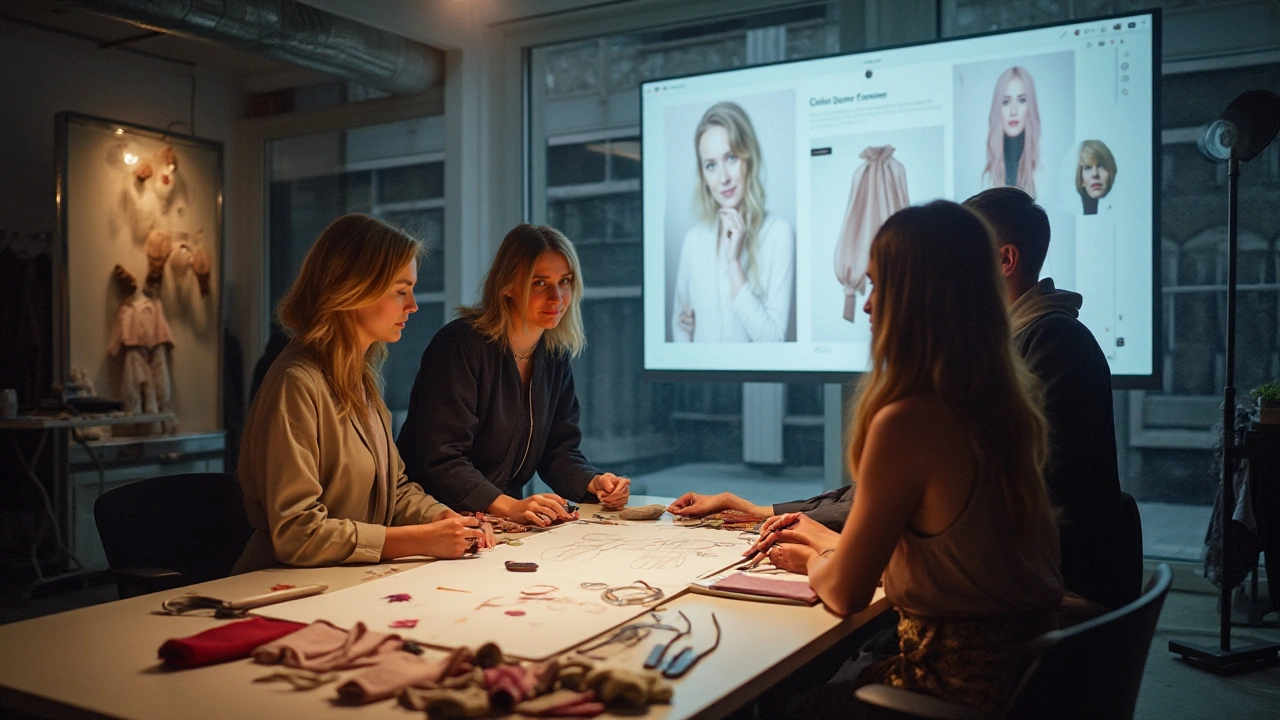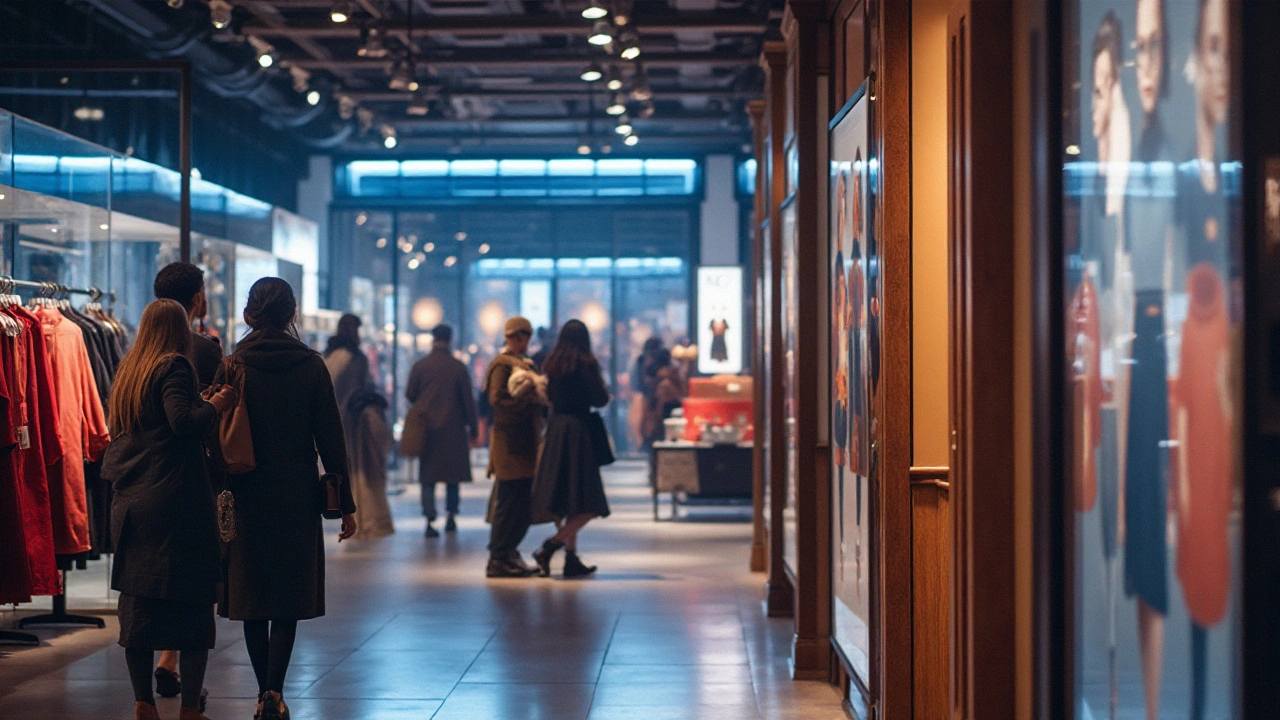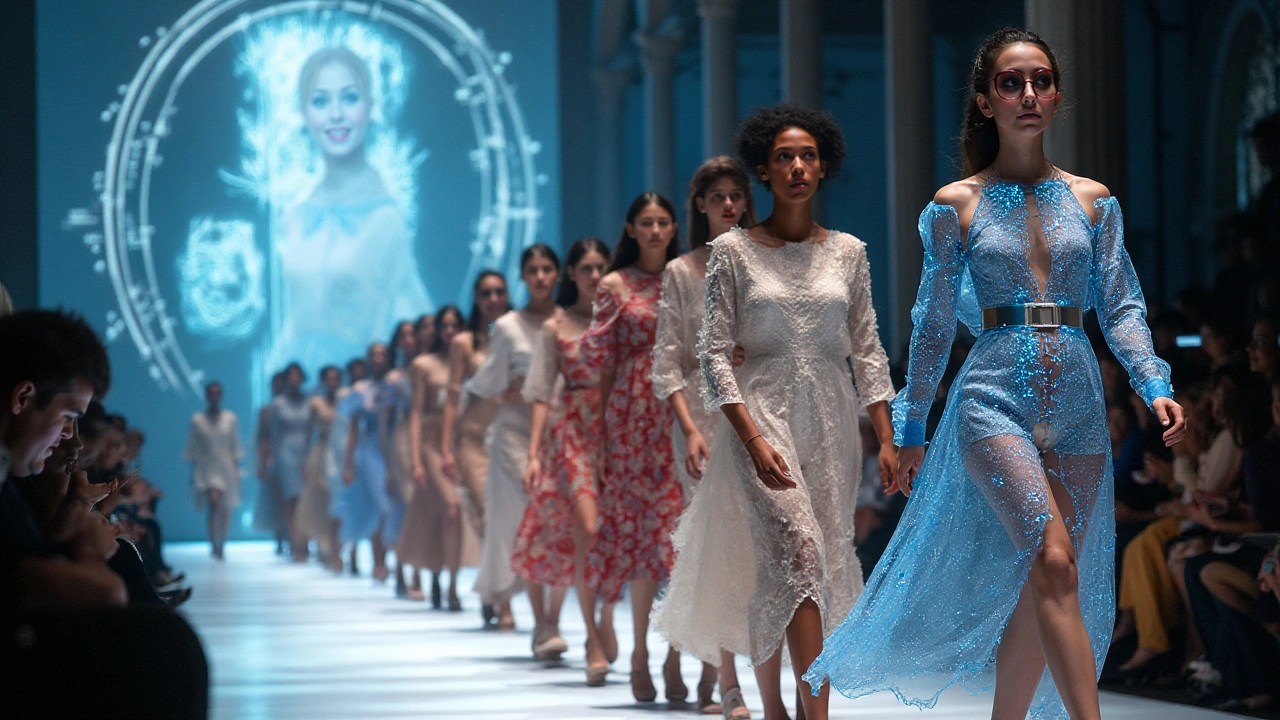Fashion is an ever-evolving form of art and expression, and artificial intelligence is making sure it keeps pace with the times. As technology pervades deeper into the production and consumption circles, AI has become a crucial player in the fashion game. It's no longer just about dressing mannequins or setting up glamorous runway shows; now it's about turning data-rich insights into groundbreaking styles.
From personal shoppers to digital wardrobes, AI offers a personalized touch that aligns with the consumer's unique tastes. Imagine stepping into a virtual fitting room where the digital mirror alters its reflections based on AI analysis of your past preferences and trending styles. The same algorithms that once seemed the stuff of sci-fi are now predicting fashion trends with astonishing accuracy.
The backbone of many modern fashion enterprises lies in the intelligent automation and precise data analysis AI provides. In the intricate dance of textiles, design, and marketing, AI ensures that brands can meet consumer demands swiftly and sustainably. As we dive into the specifics, it's apparent how deeply these technologies are infused with creativity and innovation, shaping the fashion panorama for years to come.
- AI and Personalized Fashion
- Predicting Trends with AI
- AI in Fashion Design and Manufacturing
- Retail Management and Consumer Experience
- Sustainable Practices Informed by AI
AI and Personalized Fashion
In the realm of fashion, nothing quite captivates like a piece that feels personally curated. The introduction of AI has fundamentally transformed how personalization is achieved, blending technology with creativity in unprecedented ways. Imagine having a digital stylist that not only understands your size but also your mood, style, and even your calendar. This transformative approach to customization is reshaping how we think about clothes, making each purchase feel tailored to perfection.
The secret sauce behind this personalization lies in data. By analyzing countless data points—from preferences and purchase history to social media activity—advanced AI systems can predict what a customer might want next. As more consumers embrace online shopping, the demands for personalized experiences have surged. AI tools use predictive analytics to recommend outfits not only based on past behaviors but also by integrating the latest fashion trends. This ensures that consumers aren't just revisiting old favorites, but also exploring the cutting edge of style. A report from McKinsey & Company suggests that personalized styling could boost sales by up to 10%, demonstrating its significant impact.
One fascinating aspect of AI in personalization is virtual fitting rooms. These digital spaces allow users to 'try on' clothing items without setting foot in a physical store. Powered by augmented reality and AI, these virtual platforms consider multiple factors—a user’s body dimensions, the fabric's stretch, and fit dynamics—to provide accuracy that's nearly as effective as a physical fitting. Virtual trials cut down on returns, making shopping more efficient and enjoyable. They mirror the tactile experience of shopping, recreated in the digital realm where AI draws inspiration from style innovation.
"The future of fashion lies not in size but in fit," remarked an article in Vogue, highlighting how AI is moving away from a one-size-fits-all approach to a more individualized experience.
For brands, these AI tools are more than just a way to keep up with competitors; they are indispensable in crafting a unique consumer journey. Customization platforms like Stitch Fix leverage AI-driven algorithms to curate boxes of clothes tailored to the individual’s taste, providing that 'wow' moment when opening a package. Such platforms rely heavily on artificial intelligence for continuous improvement, learning more about user preferences over time to enhance recommendations.
In a world where consumers crave unique experiences, AI ensures that fashion doesn't just meet but exceeds those expectations. It facilitates a dialogue between the brand and the user, where clothing becomes a medium of self-expression closely aligned with personal identity. AI, by seamlessly blending data and creativity, is forging a new path in personalized fashion, promising a future where every wardrobe choice is a reflection of one's individual essence.
Predicting Trends with AI
The influence of artificial intelligence in the fashion industry is creating waves, especially when it comes to predicting trends. The old-world charm of trend forecasters who relied on intuition and experience has now mixed with cutting-edge AI technology that offers insights previously unimaginable. Fashion forecasting has become a blend of art and science, where AI analyzes vast datasets to predict what styles might captivate audiences next. These intelligent systems don’t just look at what’s happening on the catwalks but draw from social media, ecommerce platforms, and cultural shifts to understand the fashion zeitgeist.
One intriguing method being used is image recognition, where AI algorithms scan millions of photos from social media platforms. This helps identify patterns in colors, shapes, and styles that are gaining popularity. By processing this visual data, AI can detect nuanced changes in consumer preferences long before they become apparent in mainstream fashion circles. This technology doesn’t just focus on what's popular but also analyzes demographic and geographic differences, offering brands a segmented view of how trends differ worldwide.
AI’s analytical capabilities are transforming brands’ abilities to predict what their customers will want next season, and they’re doing it with uncanny accuracy. Major fashion players like Zara and H&M already integrate AI for trend forecasting to stock their stores with items their customers are most likely to purchase. By closely studying consumer behavior, these brands manage to stay ahead of the curve, tailoring their offerings to meet the rapidly changing demands of their audience. According to a report by McKinsey, companies using AI for such predictive measures boast an average 5-10% increase in sales.
Interestingly, this predictive power is not just shaping the end products but also influencing the creative process itself. Designers now often rely on AI’s insights to guide their creative direction, ensuring their work resonates with consumers’ expectations. This shift represents a more collaborative approach between technology and creativity. “AI is not replacing creativity in fashion; it's augmenting it,” said a spokesperson for a leading AI-driven fashion analytics company. Amidst the digital shift, AI brings precision to creativity, adding structured data analysis to previously intuition-driven choices.
Looking deeper, AI's role extends to enhancing fashion’s sustainability focus. By predicting production needs more accurately, AI helps reduce waste from overproduction, a common issue in fashion retail. It advises on stocking only what is necessary and customizing sizes and fits, thereby also contributing to the industry’s move towards sustainability. A recent study found that overstocking can be slashed by up to 50% when brands utilize predictive analytics.
As the fashion industry continues to embrace AI, the balance between human creativity and machine precision becomes more seamless. With the ability to predict trends with almost surgical precision, fashion brands not only satisfy current demands but also start setting the trends themselves. The intersection of these technologies with creativity heralds an exciting era for fashion, one where the anticipation of what’s next could be charted as precisely as it is imagined.

AI in Fashion Design and Manufacturing
In recent years, the integration of artificial intelligence into fashion design and manufacturing has been nothing short of transformative. Designers and manufacturers are now leveraging AI algorithms to streamline and enhance every step of the creative and production process. This technological evolution is not just a boon for efficiency; it also opens the doors to unprecedented levels of creativity. Designers today can tap into a vast reservoir of historical and emerging trend data to inform their creations, thanks to AI's data-crunching capabilities. It is akin to having an omnipotent assistant guiding them through the decades of fashion's past while projecting bold, innovative designs for the future.
One key application of AI in fashion design is its ability to analyze current and past fashion data to predict upcoming trends. This predictive power goes beyond mere guesswork; it uses historical data to forecast what colors, fabrics, and styles will captivate the masses next season. This insight allows designers to start conceptualizing months in advance, aligning their collections with future demand. The capability to identify the zeitgeist before it fully emerges gives brands a significant edge in a crowded market. Companies like Heuritech, using AI and real-time analysis from social media platforms, aid designers in gauging public engagement and feedback almost instantaneously.
Manufacturing, too, finds a powerful ally in AI, transforming complex processes into efficient, data-driven operations. Automation supported by AI streamlines repetitive tasks such as fabric cutting, tracking inventory, and even sewing, drastically reducing the time and cost involved. AI's precision leads to less material waste, which is both cost-effective and environmentally friendly. According to a McKinsey report, AI-driven improvements in production can lead to cost reductions of up to 25%, a remarkable figure for an industry often criticized for wastefulness and inefficiency. This helps brands not only cut costs but also align more closely with sustainable practices, a crucial demand of today's eco-conscious consumers.
At the core of these innovations is the fusion of human creativity and AI's analytical strength. While AI suggests patterns, textures, and colors based on data, it does not replace the irreplaceable human touch; it complements it. A designer's vision, when married to AI's exhaustive data correlations, can result in garments that resonate profoundly with consumers. As Burberry's Chief Creative Officer, Riccardo Tisci, once noted, "AI helps us see beyond the limits of our own imagination, to unearth styles and concepts we may not have considered without its insights."
AI's integration into fashion design and manufacturing also extends to customisation, allowing for personalized fashion on a large scale. By analyzing an individual’s past purchases, browsing behavior, and social media activity, AI can suggest tailored products that fit their personal style. Tools like Thread's Style Bot provide personalized fashion advice by using machine learning to understand each user’s unique style preferences. This capability not only enhances customer experience but also fosters brand loyalty by making consumers feel seen and understood.
The continuous evolution of AI technologies promises even more exciting developments in fashion design and manufacturing. It ignites a new era where fashion can be smarter, more efficient, and infinitely more exciting. As AI continues to develop, one can only imagine the creative possibilities waiting for fashion brands willing to embrace this wave of technological innovation. The fashion world stands at the cusp of a new revolution, a playground where artificial intelligence unlocks realms of designs yet to be dreamt.
Retail Management and Consumer Experience
The integration of artificial intelligence into retail management represents a seismic shift in how fashion brands interact with consumers. AI systems analyze vast amounts of data to comprehend consumer behavior, ensuring that the retail space far surpasses traditional expectations in tailoring user experiences. When a customer steps into a shop or logs onto an online platform, they are greeted by a personalized selection of products, thanks to the algorithms quietly working behind the scenes.
These sophisticated mechanisms can predict what garments you'll be drawn to based on previous purchases and current fashion trends. As a result, retailers can manage inventory more effectively, ensuring popular items are on hand to prevent the dreaded 'out of stock' scenario. At the same time, AI helps in pricing strategies – analyzing data to suggest optimal prices for goods, often dynamically altering them based on supply and demand insights. These systems not only enhance consumer satisfaction but also bolster the retailer's bottom line.
An exciting development in AI-empowered retail is the rise of virtual stylists. AI chatbots and assistants provide instant fashion advice, responding rapidly to queries and suggesting outfits based on user's past behaviors and preferences. This personalized attention mirrors, or even surpasses, the experience of having a personal shopper. Incorporating these technological assistants into retail operations not only improves the customer experience but also optimizes employee resources, allowing human staff to focus on more strategic tasks.
An industry analyst once noted, "AI in retail is not just about selling more; it's about enhancing the entire customer journey and making each interaction more meaningful."
The technology enhances the physical shopping experience as well. Some stores have experimented with AI-powered smart mirrors that utilize augmented reality to show customers how they'd look in an outfit, without physically trying it on. This innovation reduces dressing room congestion and allows customers to make quicker, more confident purchasing decisions. Such AI-driven tools cater to convenience and immediacy, which are increasingly desirable in today’s fast-paced world.
Moreover, AI helps bridge the online and offline shopping worlds. For instance, attributes like ‘click and collect’ are streamlined using AI systems that efficiently coordinate stock levels and logistics, ensuring a seamless experience whether a purchase begins on a website or within a physical shop. A notable feature of AI's retail influence is its ability to adeptly handle cross-channel integrations, blending online and offline data to give retailers a unified view of their customer's journey.
AI doesn't just stop there; it contributes significantly to refining after-sales service. Sentiment analysis tools, powered by AI, scan social media and other feedback channels to quickly react to consumer opinions – positive or negative. This proactive approach allows brands to swiftly address concerns, enhance product satisfaction, and build a stronger, loyalty-driven relationship with their clientele. AI undoubtedly redefines how fashion brands perceive and engage with consumers, making the shopping experience decidedly futuristic.

Sustainable Practices Informed by AI
In recent years, the push for sustainability in all aspects of life has gained considerable momentum. The fashion industry, known for its fast-cycle production and substantial waste output, has become a focal point in this movement. Here, artificial intelligence has emerged as a vital tool, transforming how brands approach sustainability. By leveraging complex algorithms and vast amounts of data, AI helps drive eco-friendly innovations that cater to the growing demand for environmentally conscious products.
One significant impact of AI in sustainable fashion is its ability to optimize supply chains. By analyzing data from various sources, AI systems can predict demand more accurately, leading to minimized waste and overproduction. Brands can then adjust their production schedules and material procurement accordingly, ensuring resources are used more efficiently. AI also aids in selecting sustainable materials, offering insights into the environmental impact of different fabrics and processes. This knowledge empowers designers to make informed choices, balancing creativity with ecological responsibility.
Innovative AI-Driven Solutions
Moreover, AI fosters innovative recycling processes within the industry. Advanced vision technology, a branch of AI, can now identify and sort fabrics with precision, resulting in improved recycling rates. This technology enables brands to create circular fashion models, where old garments are efficiently repurposed into new products. The adaptability of AI systems means they can quickly incorporate the latest sustainable practices and regulations, ensuring fashion brands remain ahead of the curve in their environmental efforts.
"AI not only enhances efficiency but also paves the way for a more sustainable future," says Clara Davis, Director of Sustainable Fashion at Eco Innovations.
The impact of AI extends beyond production; it's instrumental in promoting conscious consumerism. Intelligent recommendation systems guide consumers toward making eco-friendly choices based on their shopping behaviors and personal preferences. Brands are now able to label products with detailed sustainability ratings, which are learned from AI's analysis of supply chain data and carbon footprint calculations. This transparency facilitates trust and drives consumer engagement with sustainable products.
Data-Driven Environmental Insights
Equally noteworthy is AI's capability to analyze environmental data and predict future sustainability trends. Through machine learning models, AI provides insights into the potential effects of fashion industry practices on climate change. Brands are equipped with data-driven forecasts, allowing them to implement proactive strategies in reducing their carbon footprints. AI identifies patterns and shifts in consumer sentiment regarding sustainability, aiding brands in aligning their initiatives with societal expectations.
Statistics reveal that fashion companies adopting AI to bolster their sustainability efforts have seen up to a 25% reduction in their yearly waste production. Such figures emphasize the substantial benefits AI technologies offer when effectively integrated into operational processes, transforming not only how clothes are made but also how the industry views its role in the global environment.

